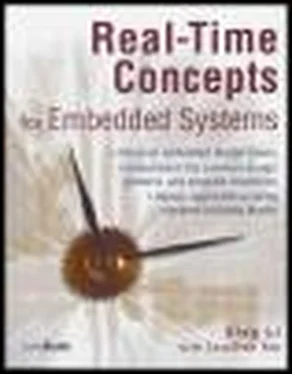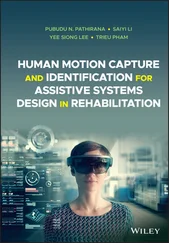Imagine a real-time weapons defense system whose role is to protect a naval destroyer by shooting down incoming missiles. The idea is to shred an incoming missile into pieces with bullets before it reaches the ship. The weapons system is comprised of a radar system, a command-and-decision (C&D) system, and weapons firing control system. The controlling system is the C&D system, whereas the controlled systems are the radar system and the weapons firing control system.
· The radar system scans and searches for potential targets. Coordinates of a potential target are sent to the C&D system periodically with high frequency after the target is acquired.
· The C&D system must first determine the threat level by threat classification and evaluation, based on the target information provided by the radar system. If a threat is imminent, the C&D system must, at a minimum, calculate the speed and flight path or trajectory, as well as estimate the impact location. Because a missile tends to drift off its flight path with the degree of drift dependent on the precision of its guidance system, the C&D system calculates an area (a box) around the flight path.
· The C&D system then activates the weapons firing control system closest to the anticipated impact location and guides the weapons system to fire continuously within the moving area or box until the target is destroyed. The weapons firing control system is comprised of large-caliber, multi-barrel, high-muzzle velocity, high-power machine guns.
In this weapons defense system example, the communication between the radar system and the C&D system is aperiodic, because the occurrence of a potential target is unpredictable and the potential target can appear at any time. The communication between the C&D system and the weapons firing control system is, however, periodic because the C&D system feeds the firing coordinates into the weapons control system periodically (with an extremely high frequency). Initial firing coordinates are based on a pre-computed flight path but are updated in real-time according to the actual location of the incoming missile.
Consider another example of a real-time system-the cruise missile guidance system. A cruise missile flies at subsonic speed. It can travel at about 10 meters above water, 30 meters above flat ground, and 100 meters above mountain terrains. A modern cruise missile can hit a target within a 50-meter range. All these capabilities are due to the high-precision, real-time guidance system built into the nose of a cruise missile. In a simplified view, the guidance system is comprised of the radar system (both forward-looking and look-down radars), the navigation system, and the divert-and-altitude-control system. The navigation system contains digital maps covering the missile flight path. The forward-looking radar scans and maps out the approaching terrains. This information is fed to the navigation system in real time. The navigation system must then recalculate flight coordinates to avoid terrain obstacles. The new coordinates are immediately fed to the divert-and-altitude-control system to adjust the flight path. The look-down radar periodically scans the ground terrain along its flight path. The scanned data is compared with the estimated section of the pre-recorded maps. Corrective adjustments are made to the flight coordinates and sent to the divert-and-altitude-control system if data comparison indicates that the missile has drifted off the intended flight path.
In this example, the controlling system is the navigation system. The controlled systems are the radar system and the divert-and-altitude-control system. We can observe both periodic and aperiodic communications in this example. The communication between the radars and the navigation system is aperiodic. The communication between the navigation system and the diver-and-altitude-control system is periodic.
Let us consider one more example of a real-time system-a DVD player. The DVD player must decode both the video and the audio streams from the disc simultaneously. While a movie is being played, the viewer can activate the on-screen display using a remote control. On-screen display is a user menu that allows the user to change parameters, such as the audio output format and language options. The DVD player is the controlling system, and the remote control is the controlled system. In this case, the remote control is viewed as a sensor because it feeds events, such as pause and language selection, into the DVD player.
1.2.2 Characteristics of Real-Time Systems
The C&D system in the weapons defense system must calculate the anticipated flight path of the incoming missile quickly and guide the firing system to shoot the missile down before it reaches the destroyer. Assume T1 is the time the missile takes to reach the ship and is a function of the missile's distance and velocity. Assume T2 is the time the C&D system takes to activate the weapons firing control system and includes transmitting the firing coordinates plus the firing delay. The difference between T1 and T2 is how long the computation may take. The missile would reach its intended target if the C&D system took too long in computing the flight path. The missile would still reach its target if the computation produced by the C&D system was inaccurate. The navigation system in the cruise missile must respond to the changing terrain fast enough so that it can re-compute coordinates and guide the altitude control system to a new flight path. The missile might collide with a mountain if the navigation system cannot compute new flight coordinates fast enough, or if the new coordinates do not steer the missile out of the collision course.
Therefore, we can extract two essential characteristics of real-time systems from the examples given earlier. These characteristics are that real-time systems must produce correct computational results, called logical or functional correctness , and that these computations must conclude within a predefined period, called timing correctness.
Real-time systems are defined as those systems in which the overall correctness of the system depends on both the functional correctness and the timing correctness. The timing cor-rectness is at least as important as the functional correctness.
It is important to note that we said the timing correctness is at least as important as the functional correctness. In some real-time systems, functional correctness is sometimes sacrificed for timing correctness. We address this point shortly after we introduce the classifications of real-time systems.
Similar to embedded systems, real-time systems also have substantial knowledge of the environment of the controlled system and the applications running on it. This reason is one why many real-time systems are said to be deterministic, because in those real-time systems, the response time to a detected event is bounded. The action (or actions) taken in response to an event is known a priori. A deterministic real-time system implies that each component of the system must have a deterministic behavior that contributes to the overall determinism of the system. As can be seen, a deterministic real-time system can be less adaptable to the changing environment. The lack of adaptability can result in a less robust system. The levels of determinism and of robustness must be balanced. The method of balancing between the two is system- and application-specific. This discussion, however, is beyond the scope of this book. Consult the reference material for additional coverage on this topic.
1.2.3 Hard and Soft Real-Time Systems
In the previous section, we said computation must complete before reaching a given deadline. In other words, real-time systems have timing constraints and are deadline-driven. Real-time systems can be classified, therefore, as either hard real-time systems or soft real-time systems.
Читать дальше












